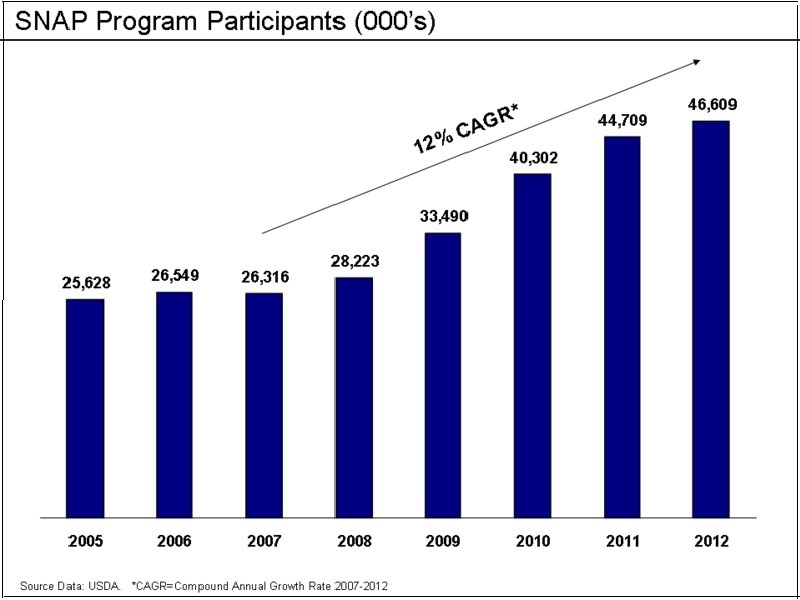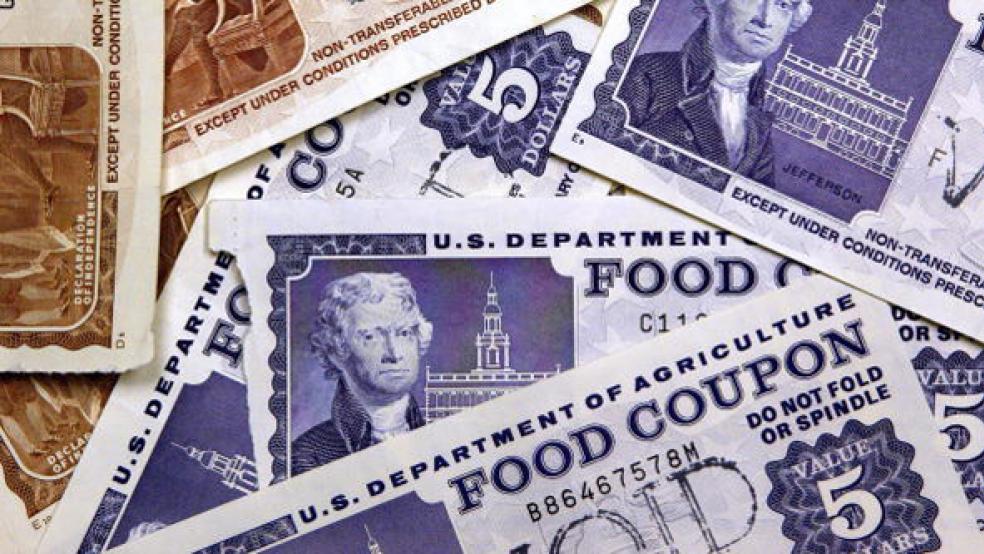Everyone is aware of SNAP (food stamps), the mother of all food handouts, where over 47.8 million people participate at an annual cost of $81 billion. But awareness of the sprawling array of other government food programs is another eye opener.
WIC, for example, the Women, Infants and Children Food and Nutrition Service, started small in 1968 to help poor and undernourished mothers-to-be. It now covers 53 percent of all infants in America at an annual cost of $8.8 billion, and involves 90 state agencies, 1,836 bureaus and 9,000 clinics.
Related: Puzzling Rise in Food Stamp Use as Economy Improves
This now staggering project is a gateway to many other government-funded entitlement programs, including SNAP. There are, of course, lots of rules and the catalogue of approved foods is mind-boggling. Under WIC, mothers to be can’t buy white potatoes (insufficiently nutritious), imported cheeses or cheese spreads and only 9 types of domestic cheeses are approved. Canned beans are fine, but not if they include pork or frankfurters. Moms may buy a gallon of milk, but only in gallon containers, not two half-gallons.
Compare that to SNAP, where a veritable buffet of junk food can be bought with taxpayer dollars, including Double Stuf Oreos, Breyers Cookies and Cream ice cream, Kit Kat Milk Chocolate and Snickers, Cheez-It snacks, a fountain of calorie laden sodas, including energy drinks like Monster, Red Bull and Rockstar, and of course, Starbuck’s coffee.

The spread of free school lunches—and now free breakfasts-- is another story. In 1969, some 2.9 million youngsters received free lunches daily. By 2012, there were 18.7 million free lunches, 68.2 percent of all school lunches. What about free food during summer? No problem thanks to the Seamless Summer Option. Now ALL children can eat free in communities where 50 percent of all children are eligible for free or reduced-cost meals—that’s about two-thirds of all schools with lunch programs. In large part, the 50 percent of lunches that go to apparently ineligible youngsters are given to avoid stigmatizing the eligible.
Related: Food Stamps—Desperate Need or Double Dealing?
Children are eligible for free school lunches if their family income falls below 130 percent of the government’s poverty level In 2012, the income cut-off for a household of three—single mother, two children—would be $24,817. Cash welfare payments are included as income but excluded are Section 8 housing subsidies, Medicare, so-called food stamps and government-paid entitlements.
The lesser-known school breakfast program now covers 12.9 million students and costs $3.3 billion a year. The USDA wants to expand it and is actively mobilizing parents and teachers to offer free breakfasts. A visit to the USDA Web site offers a step-by-step plan to expand free breakfasts.
These two programs comprise only a small portion of Washington’s free food projects. What does this benevolence tell us about today’s America? These programs are permanent and will undoubtedly expand in scope and bureaucracy regardless of which party controls the White House.
Food service workers are already complaining about budget-busting paperwork regarding menus, portion size, and salt content, while trying to follow detailed rules on sanitation, total calories and the origins of foods. I predict that dietary fashion and medical issues will soon infuse these programs. We will have kosher food, halal food, vegan/vegetarian food and food to combat real and imagined allergies. Receiving free government food is being mainstreamed as a right no different from “free” fire and police protection.
Related: Free Food at Walmart—Debit Card Glitch Empties Shelves
Meals are given as a legal right and as such far different from a parent’s power to withhold a Twinkie until the broccoli is gone.
Yet the most serious of all the damage wrought by the government-supplied meals is how they outsource family responsibility and thereby eliminate the raison d’etre of the family itself. Put bluntly, Washington is forcibly unemploying parents by pushing relentlessly to extend these programs.
Public schools in Washington already offer showers, beds and dinners for children whose parents “forgot” to pick them up after school. Ambitious school and union leaders now talk of making schools more “family-like,” and it’s only a matter of time before schools add evening meals, nighttime snacks and weekend meals. These will undoubtedly begin as emergency measures, but, rest assured, they will be expanded so as not to stigmatize recipients.
I think we are quickly moving to what Charles Murray calls the “custodial state” in which the jobless poor survive as if they were on government-supplied life support. That this burgeoning dependency occurs at a time of economic growth is truly remarkable. The modern state’s “benevolence” is breeding ingrained dependency and “infantilizing” millions of Americans. The food programs do it one mouthful at a time.
Robert Weissberg is professor emeritus in political science at the University of Illinois.





